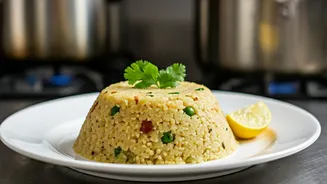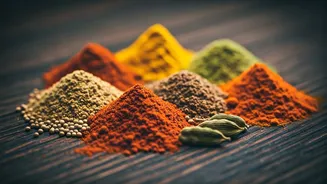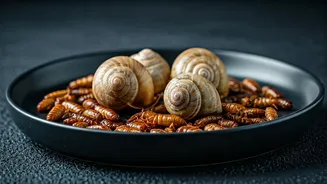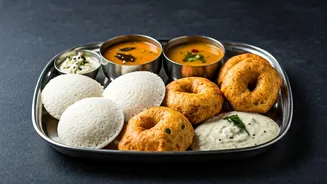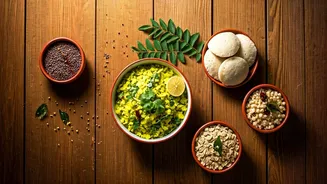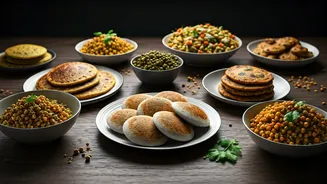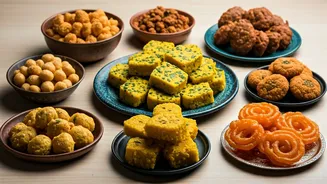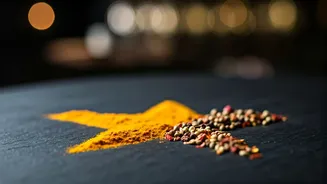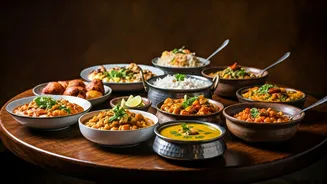Upma's Humble Beginnings
Upma, a South Indian breakfast staple, has a fascinating history. The dish is traditionally made with roasted semolina (rava or sooji) and is often flavored
with onions, green chilies, curry leaves, and mustard seeds. Originating from the Indian subcontinent, it’s a quick and easy meal, especially favored by those seeking a nutritious start to their day. Its preparation involves dry-roasting the semolina to enhance its flavor and texture, which is then cooked with water and seasoned with spices. The dish evolved from simple beginnings as a way to use readily available ingredients to become a versatile and beloved breakfast consumed throughout the country. Families often personalize the recipe, adding vegetables like peas, carrots, and even nuts to enhance its nutritional value and taste. Upma's popularity also stems from its adaptability; it can be customized to suit different tastes and preferences. It's a dish that reflects the resourcefulness and ingenuity of Indian home cooks, transforming basic ingredients into a flavorful and wholesome meal.
Global Porridge Recognition
The recent recognition of Upma as one of the 50 best porridges worldwide is a significant achievement. This accolade highlights the growing international appreciation for diverse cuisines and cooking methods. The list, likely compiled by food experts, takes into account factors like taste, texture, cultural significance, and regional variations. The fact that Upma, a dish deeply rooted in Indian tradition, has made it onto this list shows that its unique flavor profile and cooking method have resonated globally. This honor brings increased awareness of Indian cuisine, encouraging both food lovers and travelers to explore the rich culinary heritage of India. The selection likely reflects the dish's versatility; it can be a simple meal for a quick breakfast or customized with various ingredients, making it appealing to a broad audience. This recognition is a celebration of Indian culinary artistry and the ability of Upma to transcend geographical boundaries and cultural divides. It underscores the universal appeal of simple, wholesome dishes prepared with care and respect for traditional techniques.
Essential Upma Ingredients
The beauty of Upma lies in its simplicity, with a core set of ingredients forming the foundation of the dish. The star ingredient is undoubtedly semolina (rava or sooji), providing the bulk and texture. It is roasted to a golden brown to bring out a nutty flavor and texture. Then, water forms a critical component, as it helps to bind the semolina and allow it to expand, forming a thick porridge. Mustard seeds are usually added to hot oil, and they splutter, adding a distinct aroma and taste. Onions, often finely chopped, are sauteed in oil to add a sweet and savory base to the dish. Green chilies contribute a spicy element. Curry leaves, when fried in the oil, release their fragrant flavor, enhancing the aroma. Freshly chopped coriander leaves are a common garnish, giving a visual appeal to the dish. These key ingredients work together to create a balanced and appetizing meal. Many people also add vegetables such as peas, carrots, and other seasonal vegetables to enhance the nutritional value of the dish. The careful combination and cooking of these elements is what makes Upma such a distinctive breakfast option.
Upma's Regional Variations
Upma offers a remarkable showcase of India's culinary diversity through various regional variations. In some southern regions, the addition of coconut adds a sweet and tropical flavor, while some recipes use roasted cashews for a richer, crunchy experience. In certain areas, the use of urad dal, also known as black gram, is common, contributing a unique earthy taste and texture. Each variation of Upma reflects the specific culinary preferences and availability of ingredients in a region. Some cooks like to add a dash of lemon juice to elevate the flavors and create a zesty taste. In other cases, spices like asafoetida may be introduced to create a distinctive smell. The flexibility of the basic recipe allows for endless variations, accommodating diverse tastes and ingredient availabilities. Different families have developed their own unique twists on the Upma recipe, making it a truly personalized dish. These variations not only enhance the flavor but also make Upma a reflection of India's multifaceted food culture. It is a dish that invites experimentation and adaptation to suit any taste and occasion.
Health Benefits Unveiled
Upma is not just a flavorful dish; it also provides several health benefits. The core ingredient, semolina, provides a good source of carbohydrates, giving sustained energy levels throughout the morning. The addition of vegetables like onions, carrots, and peas also increase the fiber content and essential vitamins. Vegetables provide essential vitamins and minerals, contributing to overall health. The use of healthy fats, such as those in oil used for tempering, offers beneficial nutrients. Upma can also be adjusted to suit various dietary needs. For instance, those who are gluten-intolerant can make Upma with a gluten-free alternative. Adding nuts and seeds to the dish increases its protein and healthy fat content, making it a more satisfying meal. Upma offers versatility, making it an ideal option for a nutritious and delicious breakfast. This versatility ensures that a wide variety of people can include Upma as part of their daily routine.
Cooking Upma: Simple Steps
Preparing Upma, though simple, requires specific steps to achieve the perfect texture and taste. First, the semolina is dry-roasted until it turns golden brown, and this process ensures a nutty flavor. Then, in a pan, mustard seeds are added to heated oil and allowed to splutter, after which onions, green chilies, and curry leaves are added and sauteed till golden. Subsequently, water is boiled and seasoned. This flavorful water is then gradually poured into the roasted semolina, which is stirred to prevent lumps. The mixture is cooked over low heat, allowing the semolina to absorb the water and thicken. Finally, it is garnished with chopped coriander leaves. The key to excellent Upma is consistent stirring to prevent sticking and even cooking. Adding vegetables like peas and carrots during the sauteing stage adds additional nutritional value and flavor. By carefully following these steps, anyone can create a simple yet delectable breakfast dish. Practice and adaptation are key, with cooks often modifying the recipe to fit their personal preferences.


